 | –≠–ª–µ–∫—Ç—Ä–æ–Ω–Ω—ã–π –∫–æ–º–ø–æ–Ω–µ–Ω—Ç: CY2310ANZ | –°–∫–∞—á–∞—Ç—å:  PDF PDF  ZIP ZIP |
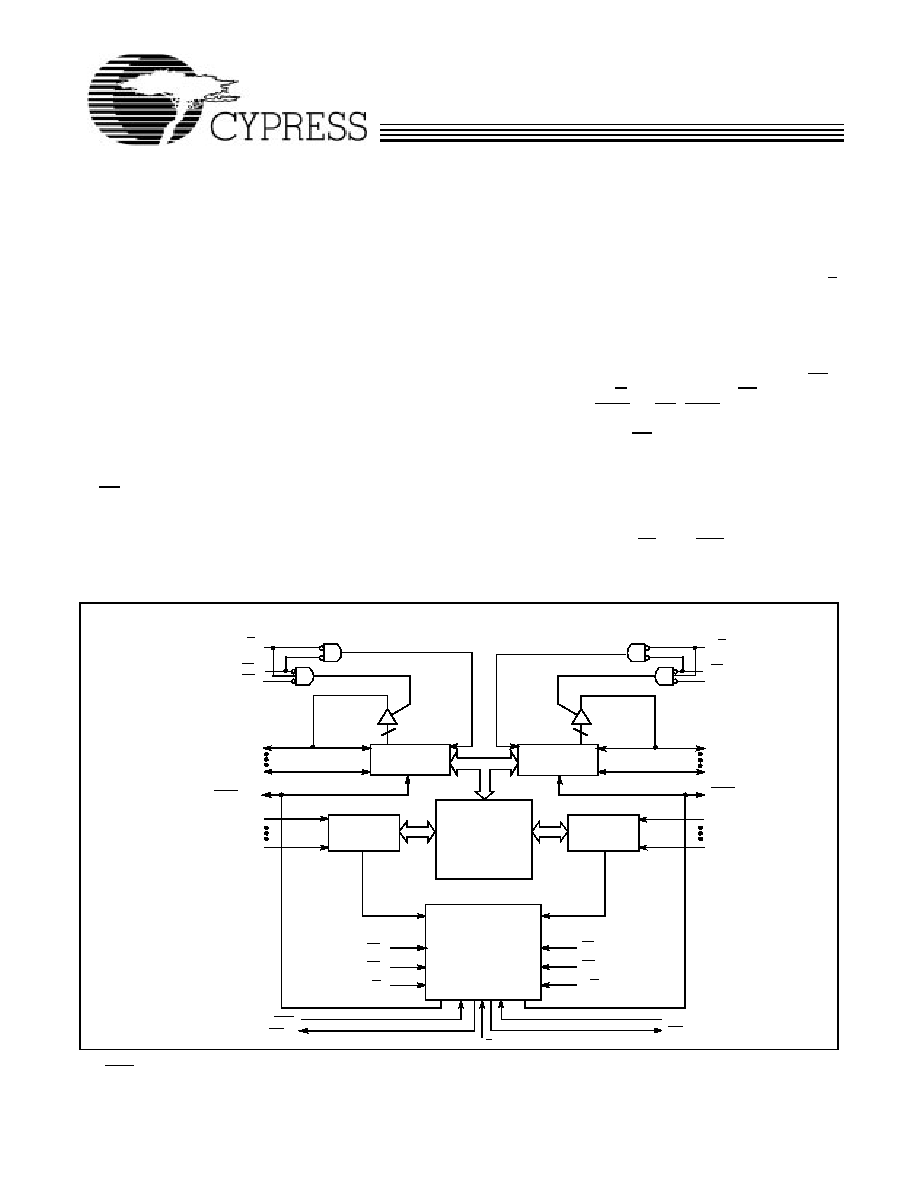
4K x 8/9 Dual-Port Static RAM
fax id: 5204
CY7C138
CY7C139
Cypress Semiconductor Corporation
∑
3901 North First Street
∑
San Jose
∑
CA 95134
∑
408-943-2600
November 1996
1CY 7C13 9
Features
∑ True Dual-Ported memory cells which allow
simultaneous reads of the same memory location
∑ 4K x 8 organization (CY7C138)
∑ 4K x 9 organization (CY7C139)
∑ 0.65-micron CMOS for optimum speed/power
∑ High-speed access: 15 ns
∑ Low operating power: I
CC
= 160 mA (max.)
∑ Fully asynchronous operation
∑ Automatic power-down
∑ TTL compatible
∑ Expandable data bus to 32/36 bits or more using
Master/Slave chip select when using more than one
device
∑ On-chip arbitration logic
∑ Semaphores included to permit software handshaking
between ports
∑ INT flag for port-to-port communication
∑ Available in 68-pin PLCC
Functional Description
The CY7C138 and CY7C139 are high-speed CMOS 4K x 8
and 4K x 9 dual-port static RAMs. Various arbitration schemes
are included on the CY7C138/9 to handle situations when mul-
tiple processors access the same piece of data. Two ports are
provided permitting independent, asynchronous access for
reads and writes to any location in memory. The CY7C138/9
can be utilized as a standalone 8/9-bit dual-port static RAM or
multiple devices can be combined in order to function as a
16/18-bit or wider master/slave dual-port static RAM. An M/S
pin is provided for implementing 16/18-bit or wider memory
applications without the need for separate master and slave
devices or additional discrete logic. Application areas include
interprocessor/multiprocessor designs, communications sta-
tus buffering, and dual-port video/graphics memory.
Each port has independent control pins: chip enable (CE),
read or write enable (R/W), and output enable (OE). Two flags are
provided on each port (BUSY and INT). BUSY signals that the port is
trying to access the same location currently being accessed by the
other port. The interrupt flag (INT) permits communication between
ports or systems by means of a mail box. The semaphores are used
to pass a flag, or token, from one port to the other to indicate that a
shared resource is in use. The semaphore logic is comprised of eight
shared latches. Only one side can control the latch (semaphore) at
any time. Control of a semaphore indicates that a shared resource is
in use. An automatic power-down feature is controlled independently
on each port by a chip enable (CE) pin or SEM pin.
The CY7C138 and CY7C139 are available in a 68-pin PLCC.
Notes:
1.
BUSY is an output in master mode and an input in slave mode.
2.
Interrupt: push-pull output and requires no pull-up resistor.
C138-1
R/W
L
CE
L
OE
L
A
11L
A
0L
A
0R
A
11R
R/W
R
CE
R
OE
R
I/O
7L
I/O
0L
I/O
7R
I/O
0R
INTERRUPT
SEMAPHORE
ARBITRATION
CONTROL
I/O
CONTROL
I/O
MEMORY
ARRAY
ADDRESS
DECODER
ADDRESS
DECODER
SEM
L
SEM
R
BUSY
L
BUSY
R
INT
L
INT
R
M/S
(7C139)I/O
8L
I/O
8R
(7C139)
Logic Block Diagram
[2]
[2]
[1, 2]
[1, 2]
R/W
L
CE
L
OE
L
R/W
R
CE
R
OE
R
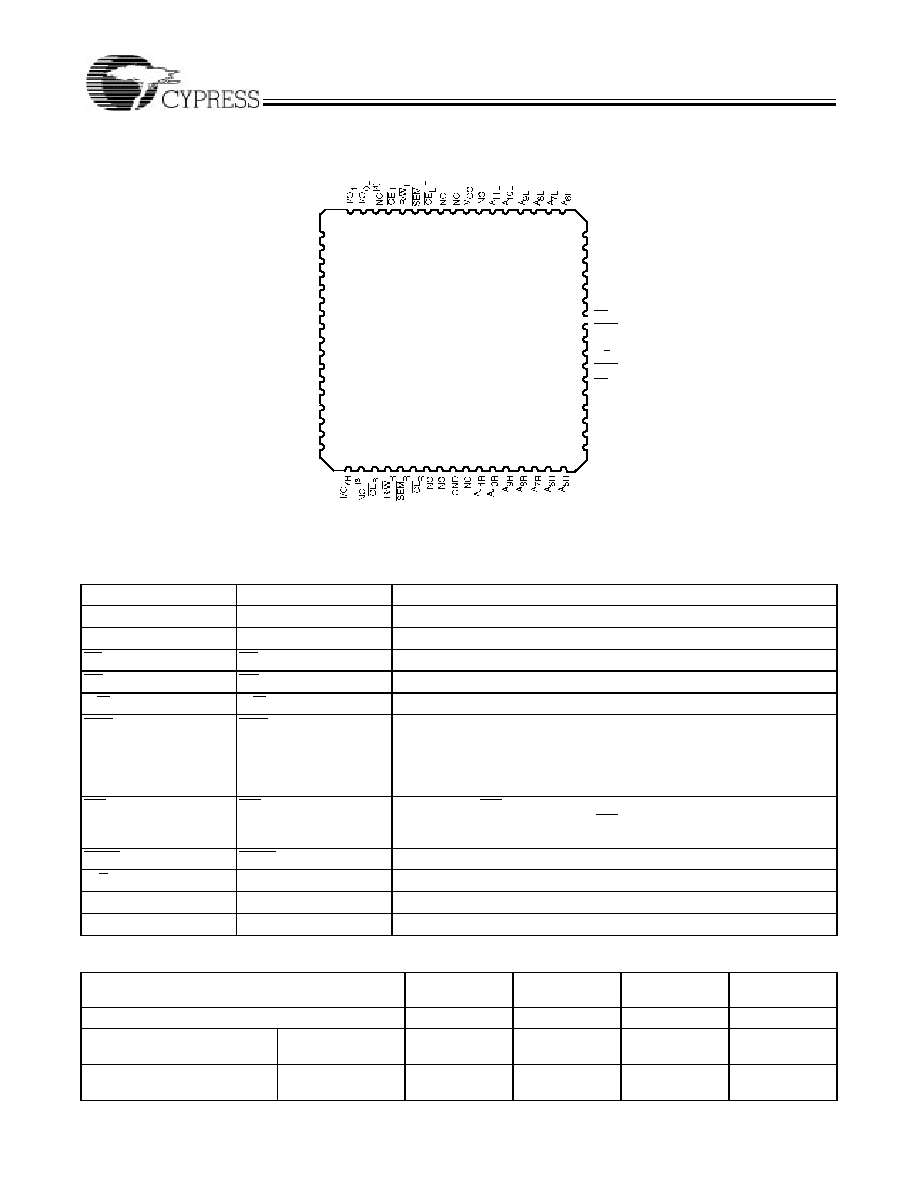
CY7C138
CY7C139
2
Pin Configurations
\
Notes:
3.
I/O
8R
on the CY7C139.
4.
I/O
8L
on the CY7C139.
10
11
12
13
14
15
16
17
18
19
20
21
22
23
24
67
Top View
68-Pin PLCC
60
59
58
57
56
55
54
53
52
51
50
49
48
3132 33 34 35 36 37 38 39 40 41 42 43
5 4 3 2 1 68
66 65 64 63 62 61
A
4L
A
3L
A
2L
A
1L
A
0L
INT
L
BUSY
L
GND
M/S
BUSY
R
INT
R
A
0R
I/O
2L
I/O
3L
I/O
4L
I/O
5L
GND
I/O
6L
I/O
7L
V
CC
GND
I/O
0R
I/O
1R
I/O
2R
V
CC
2728 29 30
9 8 7 6
47
46
45
44
A
1R
A
2R
A
3R
A
4R
I/O
3R
I/O
4R
I/O
5R
I/O
6R
25
26
A
5L
C138-2
CY7C138/9
Pin Definitions
Left Port
Right Port
Description
I/O
0L≠7L(8L)
I/O
0R≠7R(8R)
Data Bus Input/Output
A
0L≠11L
A
0R≠11R
Address Lines
CE
L
CE
R
Chip Enable
OE
L
OE
R
Output Enable
R/W
L
R/W
R
Read/Write Enable
SEM
L
SEM
R
Semaphore Enable. When asserted LOW, allows access to eight sema-
phores. The three least significant bits of the address lines will determine
which semaphore to write or read. The I/O
0
pin is used when writing to a
semaphore. Semaphores are requested by writing a 0 into the respective
location.
INT
L
INT
R
Interrupt Flag. INT
L
is set when right port writes location FFE and is cleared
when left port reads location FFE. INT
R
is set when left port writes location
FFF and is cleared when right port reads location FFF.
BUSY
L
BUSY
R
Busy Flag
M/S
Master or Slave Select
V
CC
Power
GND
Ground
Selection Guide
7C138-15
7C139-15
7C138-25
7C139-25
7C138-35
7C139-35
7C138-55
7C139-55
Maximum Access Time (ns)
15
25
35
55
Maximum Operating
Current (mA)
Commercial
220
180
160
160
Maximum Standby
Current for I
SB1
(mA)
Commercial
60
40
30
30
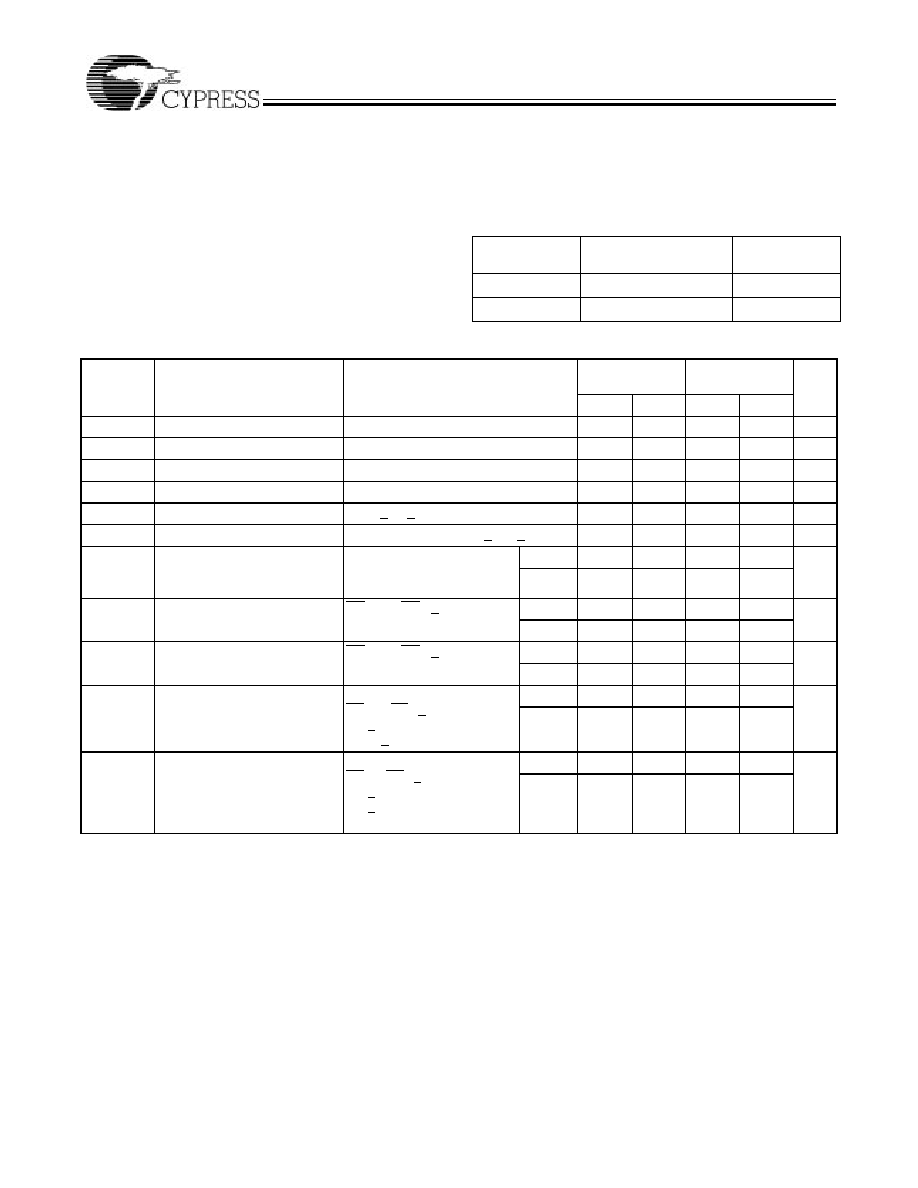
CY7C138
CY7C139
3
Maximum Ratings
(Above which the useful life may be impaired. For user guide-
lines, not tested.)
Storage Temperature ................................. ≠65
∞
C to +150
∞
C
Ambient Temperature with
Power Applied............................................. ≠55
∞
C to +125
∞
C
Supply Voltage to Ground Potential ............... ≠0.5V to +7.0V
DC Voltage Applied to Outputs
in High Z State ............................................... ≠0.5V to +7.0V
DC Input Voltage
[5]
......................................... ≠0.5V to +7.0V
Output Current into Outputs (LOW)............................. 20 mA
Static Discharge Voltage .......................................... >2001V
(per MIL≠STD≠883, Method 3015)
Latch≠Up Current ................................................... >200 mA
Operating Range
Range
Ambient
Temperature
V
CC
Commercial
0
∞
C to +70
∞
C
5V ± 10%
Industrial
≠40
∞
C to +85
∞
C
5V ± 10%
Electrical Characteristics
Over the Operating Range
Parameter
Description
Test Conditions
7C138-15
7C139-15
7C138-25
7C139-25
Unit
Min.
Max.
Min.
Max.
V
OH
Output HIGH Voltage
V
CC
= Min., I
OH
= ≠4.0 mA
2.4
2.4
V
V
OL
Output LOW Voltage
V
CC
= Min., I
OL
= 4.0 mA
0.4
0.4
V
V
IH
2.2
2.2
V
V
IL
Input LOW Voltage
0.8
0.8
V
I
IX
Input Leakage Current
GND < V
I
< V
CC
≠10
+10
≠10
+10
µ
A
I
OZ
Output Leakage Current
Output Disabled, GND < V
O
< V
CC
≠10
+10
≠10
+10
µ
A
I
CC
Operating Current
V
CC
= Max.,
I
OUT
= 0 mA,
Outputs Disabled
Com'l
220
180
mA
Ind
190
I
SB1
Standby Current
(Both Ports TTL Levels)
CE
L
and CE
R
> V
IH
,
f = f
MAX
[6]
Com'l
60
40
mA
Ind
50
I
SB2
Standby Current
(One Port TTL Level)
CE
L
and CE
R
> V
IH
,
f = f
MAX
[6]
Com'l
130
110
mA
Ind
120
I
SB3
Standby Current
(Both Ports CMOS Levels)
Both Ports
CE and CE
R
> V
CC
≠ 0.2V,
V
IN
> V
CC
≠ 0.2V
or V
IN
< 0.2V, f = 0
[6]
Com'l
15
15
mA
Ind
30
I
SB4
Standby Current
(One Port CMOS Level)
One Port
CE
L
or CE
R
> V
CC
≠ 0.2V,
V
IN
> V
CC
≠ 0.2V or
V
IN
< 0.2V, Active
Port Outputs, f = f
MAX
[6]
Com'l
125
100
mA
Ind
115
Notes:
5.
Pulse width < 20 ns.
6.
f
MAX
= 1/t
RC
= All inputs cycling at f = 1/t
RC
(except output enable). f = 0 means no address or control lines change. This applies only to inputs at CMOS
level standby I
SB3
.

CY7C138
CY7C139
4
]
Electrical Characteristics
Over the Operating Range
(continued)
Parameter
Description
Test Conditions
7C138-35
7C139-35
7C138-55
7C139-55
Unit
Min.
Max.
Min.
Max.
V
OH
Output HIGH Voltage
V
CC
= Min., I
OH
= ≠4.0 mA
2.4
2.4
V
V
OL
Output LOW Voltage
V
CC
= Min., I
OL
= 4.0 mA
0.4
0.4
V
V
IH
2.2
2.2
V
V
IL
Input LOW Voltage
0.8
0.8
V
I
IX
Input Leakage Current
GND < V
I
< V
CC
≠10
+10
≠10
+10
µ
A
I
OZ
Output Leakage Current
Output Disabled, GND < V
O
< V
CC
≠10
+10
≠10
+10
µ
A
I
CC
Operating Current
V
CC
= Max.,
I
OUT
= 0 mA,
Outputs Disabled
Com'l
160
160
mA
Ind
180
180
I
SB1
Standby Current
(Both Ports TTL Levels)
CE
L
and CE
R
> V
IH
,
f = f
MAX
[6]
Com'l
30
30
mA
Ind
40
40
I
SB2
Standby Current
(One Port TTL Level)
CE
L
and CE
R
> V
IH
,
f = f
MAX
[6]
Com'l
100
100
mA
Ind
110
110
I
SB3
Standby Current
(Both Ports CMOS Levels)
Both Ports
CE and CE
R
> V
CC
≠ 0.2V,
V
IN
> V
CC
≠ 0.2V
or V
IN
< 0.2V, f = 0
[6]
Com'l
15
15
mA
Ind
30
30
I
SB4
Standby Current
(One Port CMOS Level)
One Port
CE
L
or CE
R
> V
CC
≠ 0.2V,
V
IN
> V
CC
≠ 0.2V or
V
IN
< 0.2V, Active
Port Outputs, f = f
MAX
[6]
Com'l
90
90
mA
Ind
100
100
Capacitance
[7]
Parameter
Description
Test Conditions
Max.
Unit
C
IN
Input Capacitance
T
A
= 25
∞
C, f = 1 MHz,
V
CC
= 5.0V
10
pF
C
OUT
Output Capacitance
15
pF
AC Test Loads and Waveforms
Note:
7.
Tested initially and after any design or process changes that may affect these parameters.
3.0V
GND
90%
90%
10%
< 3 ns
< 3 ns
10%
ALL INPUT PULSES
(a) Normal Load (Load 1)
R1=893
5V
OUTPUT
R2=347
C = 30 pF
R
TH
=250
V
TH
=1.4V
OUTPUT
C=30pF
(b) ThÈ venin Equivalent(Load 1)
(c) Three-State Delay (Load 3)
C = 30 pF
OUTPUT
Load (Load 2)
C138-3
C138-4
C138-5
C138-6
C138-7
R1=893
R2=347
5V
OUTPUT
C = 5 pF
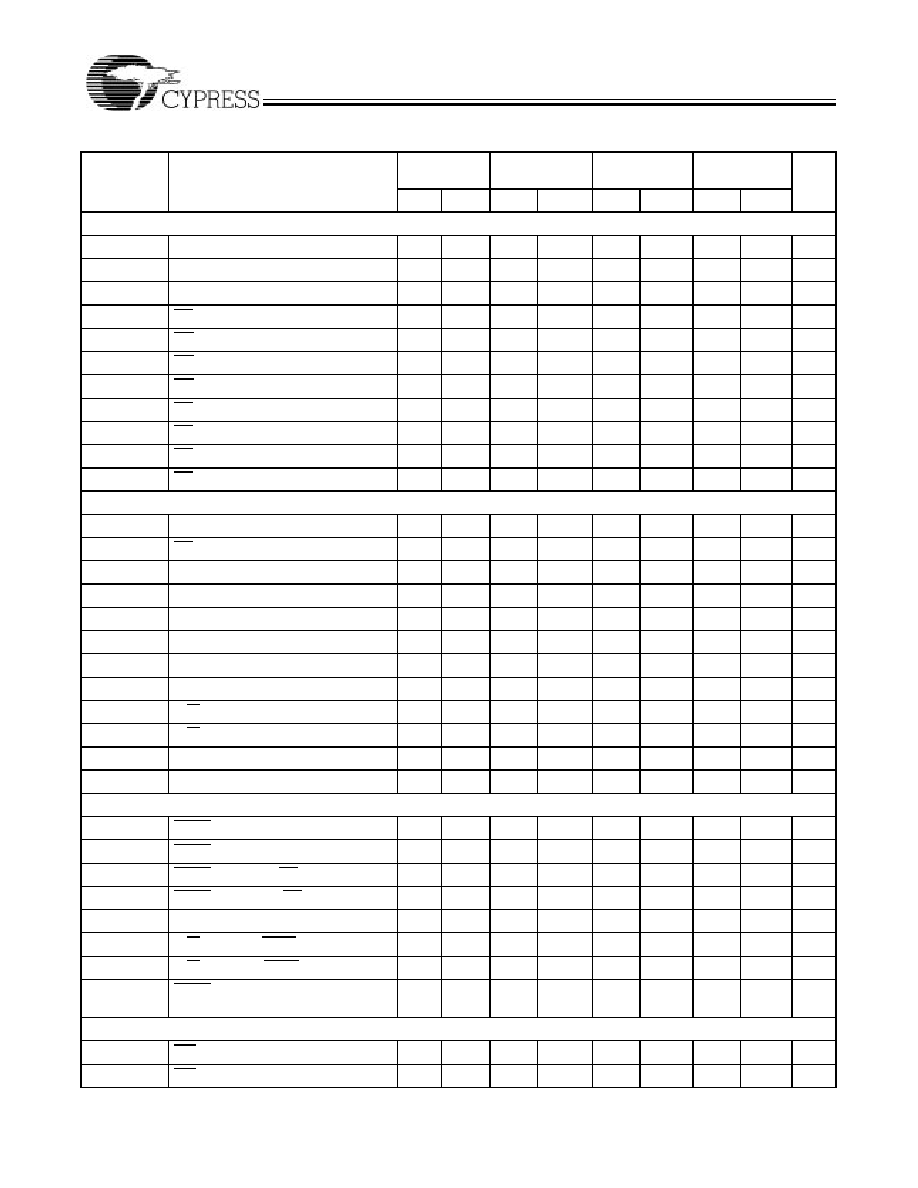
CY7C138
CY7C139
5
Switching Characteristics
Over the Operating Range
[8]
Parameter
Description
7C138-15
7C139-15
7C138-25
7C139-25
7C138-35
7C139-35
7C138-55
7C139-55
Unit
Min.
Max.
Min.
Max.
Min.
Max.
Min.
Max.
READ CYCLE
t
RC
Read Cycle Time
15
25
35
55
ns
t
AA
Address to Data Valid
15
25
35
55
ns
t
OHA
Output Hold From Address Change
3
3
3
3
ns
t
ACE
CE LOW to Data Valid
15
25
35
55
ns
t
DOE
OE LOW to Data Valid
10
15
20
25
ns
t
LZOE
[9,10,11]
OE Low to Low Z
3
3
3
3
ns
t
HZOE
[9,10,11]
OE HIGH to High Z
10
15
20
25
ns
t
LZCE
[9,10,11]
CE LOW to Low Z
3
3
3
3
ns
t
HZCE
[9,10,11]
CE HIGH to High Z
10
15
20
25
ns
t
PU
[11]
CE LOW to Power-Up
0
0
0
0
ns
t
PD
[11]
CE HIGH to Power-Down
15
25
35
55
ns
WRITE CYCLE
t
WC
Write Cycle Time
15
25
35
55
ns
t
SCE
CE LOW to Write End
12
20
30
40
ns
t
AW
Address Set-Up to Write End
12
20
30
40
ns
t
HA
Address Hold From Write End
2
2
2
2
ns
t
SA
Address Set-Up to Write Start
0
0
0
0
ns
t
PWE
Write Pulse Width
12
20
25
30
ns
t
SD
Data Set-Up to Write End
10
15
15
20
ns
t
HD
Data Hold From Write End
0
0
0
0
ns
t
HZWE
[10,11]
R/W LOW to High Z
10
15
20
25
ns
t
LZWE
[10,11]
R/W HIGH to Low Z
3
3
3
3
ns
t
WDD
[12]
Write Pulse to Data Delay
30
50
60
70
ns
t
DDD
[12]
Write Data Valid to Read Data Valid
25
30
35
40
ns
BUSY TIMING
[13]
t
BLA
BUSY LOW from Address Match
15
20
20
45
ns
t
BHA
BUSY HIGH from Address Mismatch
15
20
20
40
ns
t
BLC
BUSY LOW from CE LOW
15
20
20
40
ns
t
BHC
BUSY HIGH from CE HIGH
15
20
20
35
ns
t
PS
Port Set-Up for Priority
5
5
5
5
ns
t
WB
R/W LOW after BUSY LOW
0
0
0
0
ns
t
WH
R/W HIGH after BUSY HIGH
13
20
30
40
ns
t
BDD
[14]
BUSY HIGH to Data Valid
Note
13
Note
13
Note
13
Note
13
ns
INTERRUPT TIMING
[13]
t
INS
INT Set Time
15
25
25
30
ns
t
INR
INT Reset Time
15
25
25
30
ns
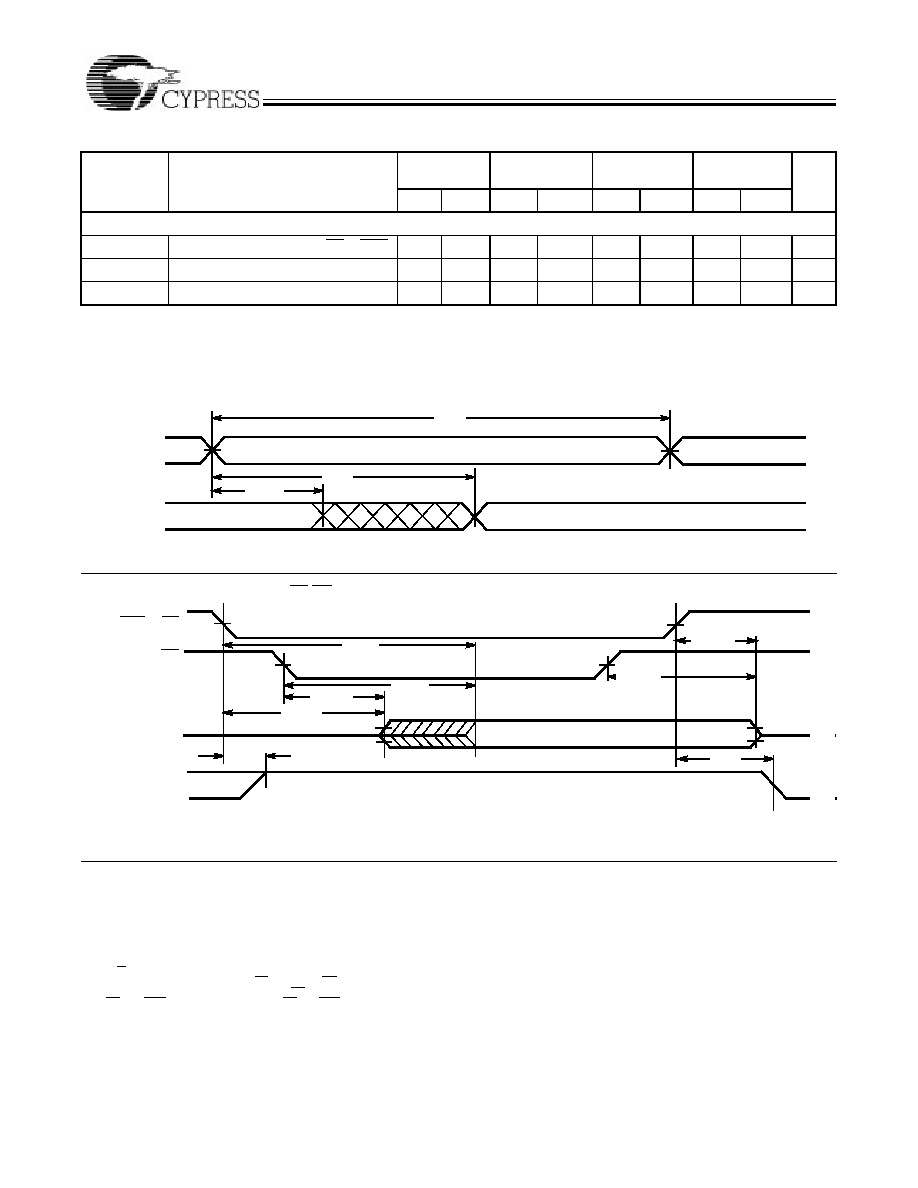
CY7C138
CY7C139
6
SEMAPHORE TIMING
t
SOP
SEM Flag Update Pulse (OE or SEM)
10
10
15
20
ns
t
SWRD
SEM Flag Write to Read Time
5
5
5
5
ns
t
SPS
SEM Flag Contention Window
5
5
5
5
ns
Switching Characteristics
Over the Operating Range
[8]
(continued)
Parameter
Description
7C138-15
7C139-15
7C138-25
7C139-25
7C138-35
7C139-35
7C138-55
7C139-55
Unit
Min.
Max.
Min.
Max.
Min.
Max.
Min.
Max.
Switching Waveforms
Notes:
8.
Test conditions assume signal transition time of 3 ns or less, timing reference levels of 1.5V, input pulse levels of 0 to 3.0V, and output loading of the specified
I
OI
/I
OH
and 30-pF load capacitance.
9.
At any given temperature and voltage condition for any given device, t
HZCE
is less than t
LZCE
and t
HZOE
is less than t
LZOE
.
10. Test conditions used are Load 3.
11.
This parameter is guaranteed but not tested.
12. For information on part-to-part delay through RAM cells from writing port to reading port, refer to Read Timing with Port-to-Port Delay waveform.
13. Test conditions used are Load 2.
14. t
BDD
is a calculated parameter and is the greater of t
WDD
- t
PWE
(actual) or t
DDD
- t
SD
(actual).
15. R/W is HIGH for read cycle.
16. Device is continuously selected CE = LOW and OE = LOW. This waveform cannot be used for semaphore reads.
17. Address valid prior to or coincident with CE transition LOW.
18. CE
L
= L, SEM = H when accessing RAM. CE = H, SEM = L when accessing semaphores.
t
RC
t
AA
t
OHA
DATA VALID
PREVIOUS DATA VALID
DATA OUT
ADDRESS
C138-8
Read Cycle No. 1 (Either Port Address Access)
[15, 16]
t
ACE
t
LZOE
t
DOE
t
HZOE
t
HZCE
DATA VALID
DATA OUT
SEM or CE
OE
t
LZCE
t
PU
I
CC
I
SB
t
PD
C138-9
Read Cycle No. 2 (Either Port CE/OE Access)
[15, 17, 18]
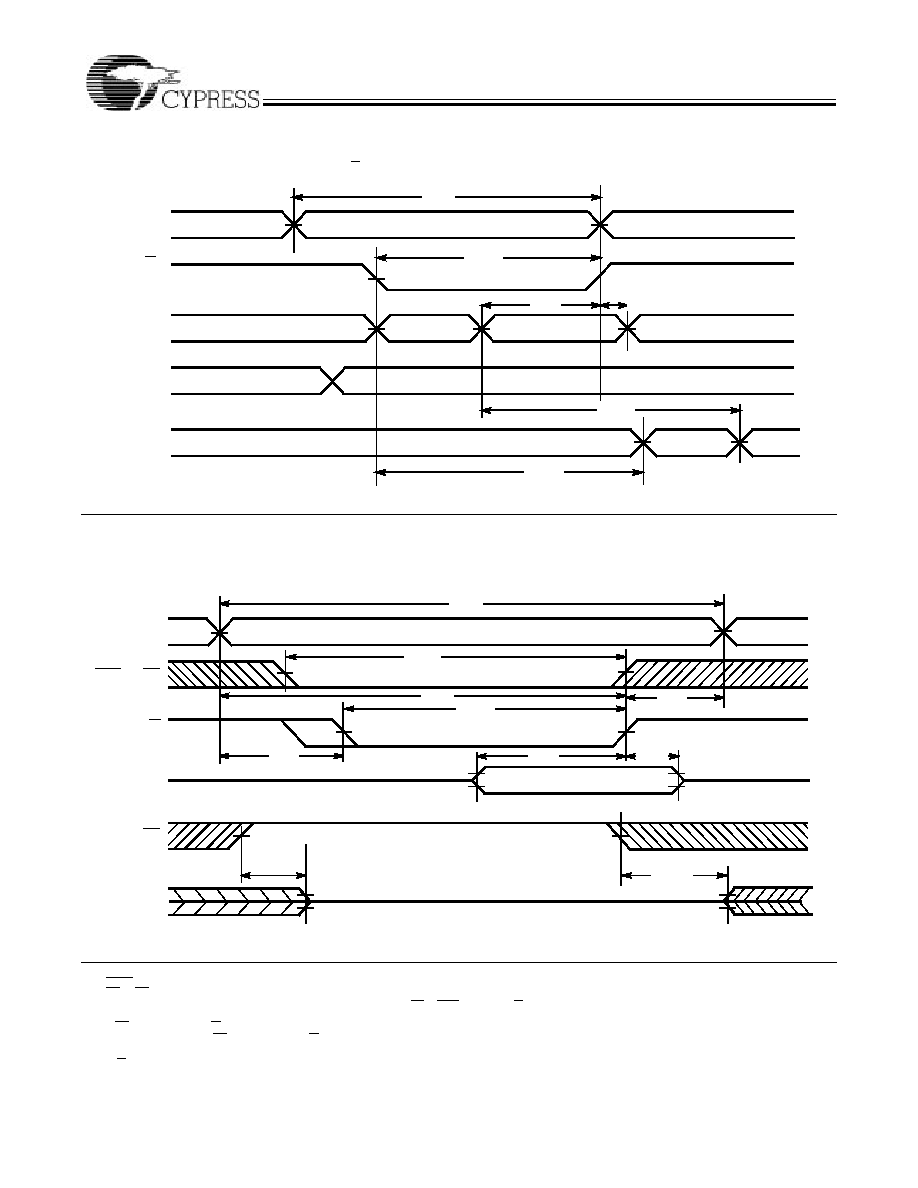
CY7C138
CY7C139
7
Notes:
19. BUSY = HIGH for the writing port.
20. CE
L
= CE
R
= LOW.
21. The internal write time of the memory is defined by the overlap of CE or SEM LOW and R/W LOW. Both signals must be LOW to initiate a write, and either signal can
terminate a write by going HIGH. The data input set-up and hold timing should be referenced to the rising edge of the signal that terminates the write.
22. If OE is LOW during a R/W controlled write cycle, the write pulse width must be the larger of t
PWE
or (t
HZWE
+ t
SD
) to allow the I/O drivers to turn off and data to be placed on the
bus for the required t
SD
. If OE is HIGH during a R/W controlled write cycle (as in this example), this requirement does not apply and the write pulse can be as short as the specified
t
PWE
.
23. R/W must be HIGH during all address transitions.
Switching Waveforms
(continued)
VALID
t
DDD
t
WDD
MATCH
MATCH
R/W
R
DATA
INR
DATA
OUTL
C138-10
t
WC
ADDRESS
R
t
PWE
VALID
t
SD
t
HD
ADDRESS
L
Read Timing with Port-to-Port Delay (M/S = L)
[19, 20]
C138-11
t
AW
t
WC
DATA VALID
HIGH IMPEDANCE
t
SCE
t
SA
t
PWE
t
HD
t
SD
t
HA
t
HZOE
t
LZOE
SEM OR CE
R/W
OE
DATA OUT
DATA IN
ADDRESS
Write Cycle No. 1: OE Three-States Data I/Os (Either Port)
[21, 22, 23]

CY7C138
CY7C139
8
Notes:
24. Data I/O pins enter high impedance when OE is held LOW during write.
25. CE = HIGH for the duration of the above timing (both write and read cycle).
Switching Waveforms
(continued)
t
AW
t
WC
t
SCE
t
SA
t
PWE
t
HD
t
SD
t
HZWE
t
HA
HIGH IMPEDANCE
SEM OR CE
R/W
DATA OUT
DATAIN
t
LZWE
DATA VALID
C138-12
ADDRESS
Write Cycle No. 2: R/W Three-States Data I/Os (Either Port)
[21, 23, 24]
t
SOP
t
AA
SEM
R/W
OE
I/O
0
C138-13
VALID ADDRESS
VALID ADDRESS
t
HD
DATA
IN
VALID
DATA
OUT
VALID
t
OHA
A
0
≠A
2
t
AW
t
HA
t
ACE
t
SOP
t
SCE
t
SD
t
SA
t
PWE
t
SWRD
t
DOE
WRITE CYCLE
READ CYCLE
Semaphore Read After Write Timing, Either Side
[25]

CY7C138
CY7C139
9
Notes:
26. I/O
0R
= I/O
0L
= LOW (request semaphore); CE
R
= CE
L
= HIGH
27. Semaphores are reset (available to both ports) at cycle start.
28. If t
SPS
is violated, the semaphore will definitely be obtained by one side or the other, but there is no guarantee which side will control the semaphore.
Switching Waveforms
(continued)
MATCH
C138-14
t
SPS
A
0L
≠A
2L
MATCH
R/W
L
SEM
L
A
0R
≠A
2R
R/W
R
SEM
R
Timing Diagram of Semaphore Contention
[26, 27, 28]
VALID
t
DDD
t
WDD
MATCH
MATCH
R/W
R
DATA IN
R
DATA
OUTL
C138-15
t
WC
ADDRESS
R
t
PWE
VALID
t
SD
t
HD
ADDRESS
L
t
PS
t
BLA
t
BHA
t
BDD
BUSY
L
Timing Diagram of Read with BUSY (M/S=HIGH)
[20]
t
PWE
R/W
BUSY
t
WB
t
WH
C138-16
Write Timing with Busy Input (M/S=LOW)
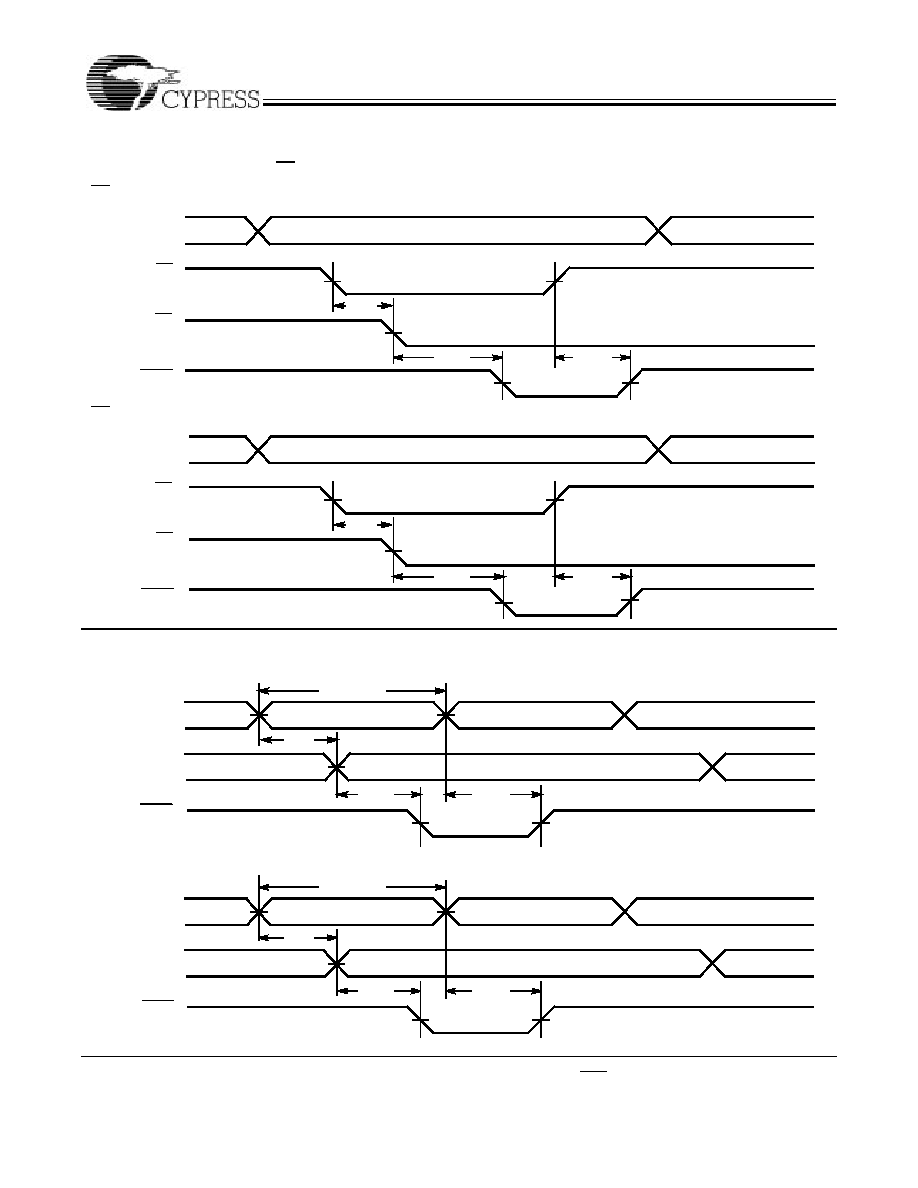
CY7C138
CY7C139
10
Note:
29. If t
PS
is violated, the busy signal will be asserted on one side or the other, but there is no guarantee on which side BUSY will be asserted.
Switching Waveforms
(continued)
ADDRESS MATCH
t
PS
t
BLC
t
BHC
ADDRESS MATCH
t
PS
t
BLC
t
BHC
CE
R
Valid First:
C138-17
ADDRESS
L,R
BUSY
R
CE
L
CE
R
BUSY
L
CE
R
CE
L
ADDRESS
L,R
C138-18
CE
L
Valid First:
Busy Timing Diagram No. 1 (CE Arbitration)
[29]
ADDRESS MATCH
t
PS
ADDRESS
L
BUSY
R
ADDRESS MISMATCH
t
RC
or t
WC
t
BLA
t
BHA
ADDRESS
R
ADDRESS MATCH
ADDRESS MISMATCH
t
PS
ADDRESS
L
BUSY
L
t
RC
or t
WC
t
BLA
t
BHA
ADDRESS
R
C138-19
C138-20
Busy Timing Diagram No. 2 (Address Arbitration)
Left Address Valid First:
Right Address Valid First:
[29]

CY7C138
CY7C139
11
Notes:
30. t
HA
depends on which enable pin (CE
L
or R/W
L
) is deasserted first.
31. t
INS
or t
INR
depends on which enable pin (CE
L
or R/W
L
) is asserted last.
Switching Waveforms
(continued)
WRITE FFF
t
WC
t
HA
READ FFF
t
RC
t
INR
WRITE FFE
t
WC
READ FFE
t
INR
t
RC
ADDRESS
R
CE
L
R/W
L
INT
L
OE
L
ADDRESS
R
R/W
R
CE
R
INT
L
ADDRESS
R
CE
R
R/W
R
INT
R
OE
R
ADDRESS
L
R/W
L
CE
L
INT
R
t
INS
t
HA
t
INS
C138-21
C138-22
C138-23
C138-24
Interrupt Timing Diagrams
Left Side Sets INT
R
:
Right Side Clears INT
R
:
Right Side Sets INT
L
:
Left Side Clears INT
L
:
[30]
[30]
[31]
[31]
[31]
[31]

CY7C138
CY7C139
12
Architecture
The CY7C138/9 consists of an array of 4K words of 8/9 bits
each of dual≠port RAM cells, I/O and address lines, and con-
trol signals (CE, OE, R/W). These control pins permit independent
access for reads or writes to any location in memory. To handle simul-
taneous writes/reads to the same location, a BUSY pin is provided on
each port. Two interrupt (INT) pins can be utilized for port≠to≠port
communication. Two semaphore (SEM) control pins are used for al-
locating shared resources. With the M/S pin, the CY7C138/9 can
function as a master (BUSY pins are outputs) or as a slave (BUSY
pins are inputs). The CY7C138/9 has an automatic power-down fea-
ture controlled by CE. Each port is provided with its own output enable
control (OE), which allows data to be read from the device.
Functional Description
Write Operation
Data must be set up for a duration of t
SD
before the rising edge
of R/W in order to guarantee a valid write. A write operation is con-
trolled by either the OE pin (see Write Cycle No. 1 waveform) or the
R/W pin (see Write Cycle No. 2 waveform). Data can be written to the
device t
HZOE
after the OE is deasserted or t
HZWE
after the falling edge
of R/W. Required inputs for non-contention operations are summa-
rized in
Table 1.
If a location is being written to by one port and the opposite
port attempts to read that location, a port-to-port flowthrough
delay must be met before the data is read on the output; oth-
erwise the data read is not deterministic. Data will be valid on
the port t
DDD
after the data is presented on the other port.
Read Operation
When reading the device, the user must assert both the OE
and CE pins. Data will be available t
ACE
after CE or t
DOE
after OE is
asserted. If the user of the CY7C138/9 wishes to access a sema-
phore flag, then the SEM pin must be asserted instead of the CE pin.
Interrupts
The interrupt flag (INT) permits communications between
ports.When the left port writes to location FFF, the right port's interrupt
flag (INT
R
) is set. This flag is cleared when the right port reads that
same location. Setting the left port's interrupt flag (INT
L
) is accom-
plished when the right port writes to location FFE. This flag is cleared
when the left port reads location FFE. The message at FFF or FFE
is user-defined. See
Table 2 for input requirements for INT. INT
R
and
INT
L
are push-pull outputs and do not require pull-up resistors to op-
erate. BUSY
L
and BUSY
R
in master mode are push-pull outputs and
do not require pull-up resistors to operate.
Busy
The CY7C138/9 provides on-chip arbitration to alleviate simul-
taneous memory location access (contention). If both ports'
CEs are asserted and an address match occurs within t
PS
of each
other the Busy logic will determine which port has access. If t
PS
is
violated, one port will definitely gain permission to the location,
but it is not guaranteed which one. BUSY will be asserted t
BLA
after an address match or t
BLC
after CE is taken LOW.
Master/Slave
A M/S pin is provided in order to expand the word width by
configuring the device as either a master or a slave. The BUSY
output of the master is connected to the BUSY input of the
slave. This will allow the device to interface to a master device
with no external components.Writing of slave devices must be
delayed until after the BUSY input has settled. Otherwise, the
slave chip may begin a write cycle during a contention situa-
tion.When presented as a HIGH input, the M/S pin allows the
device to be used as a master and therefore the BUSY line is
an output. BUSY can then be used to send the arbitration out-
come to a slave.
Semaphore Operation
The CY7C138/9 provides eight semaphore latches, which are
separate from the dual-port memory locations. Semaphores
are used to reserve resources that are shared between the two
ports.The state of the semaphore indicates that a resource is
in use. For example, if the left port wants to request a given
resource, it sets a latch by writing a zero to a semaphore loca-
tion. The left port then verifies its success in setting the latch
by reading it. After writing to the semaphore, SEM or OE must
be deasserted for t
SOP
before attempting to read the sema-
phore. The semaphore value will be available t
SWRD
+ t
DOE
after the rising edge of the semaphore write. If the left port was
successful (reads a zero), it assumes control over the shared
resource, otherwise (reads a one) it assumes the right port has
control and continues to poll the semaphore.When the right
side has relinquished control of the semaphore (by writing a
one), the left side will succeed in gaining control of the a sema-
phore.If the left side no longer requires the semaphore, a one
is written to cancel its request.
Semaphores are accessed by asserting SEM LOW. The SEM
pin functions as a chip enable for the semaphore latches (CE
must remain HIGH during SEM LOW). A
0≠2
represents the
semaphore address. OE and R/W are used in the same man-
ner as a normal memory access.When writing or reading a
semaphore, the other address pins have no effect.
When writing to the semaphore, only I/O
0
is used. If a zero is
written to the left port of an unused semaphore, a one will ap-
pear at the same semaphore address on the right port. That
semaphore can now only be modified by the side showing zero
(the left port in this case). If the left port now relinquishes control
by writing a one to the semaphore, the semaphore will be set
to one for both sides. However, if the right port had requested
the semaphore (written a zero) while the left port had control,
the right port would immediately own the semaphore as soon
as the left port released it.
Table 3 shows sample semaphore
operations.
When reading a semaphore, all eight/nine data lines output the
semaphore value. The read value is latched in an output reg-
ister to prevent the semaphore from changing state during a
write from the other port. If both ports attempt to access the
semaphore within t
SPS
of each other, the semaphore will defi-
nitely be obtained by one side or the other, but there is no guar-
antee which side will control the semaphore.
Initialization of the semaphore is not automatic and must be
reset during initialization program at power-up. All sema-
phores on both sides should have a one written into them at
initialization from both sides to assure that they will be free
when needed.
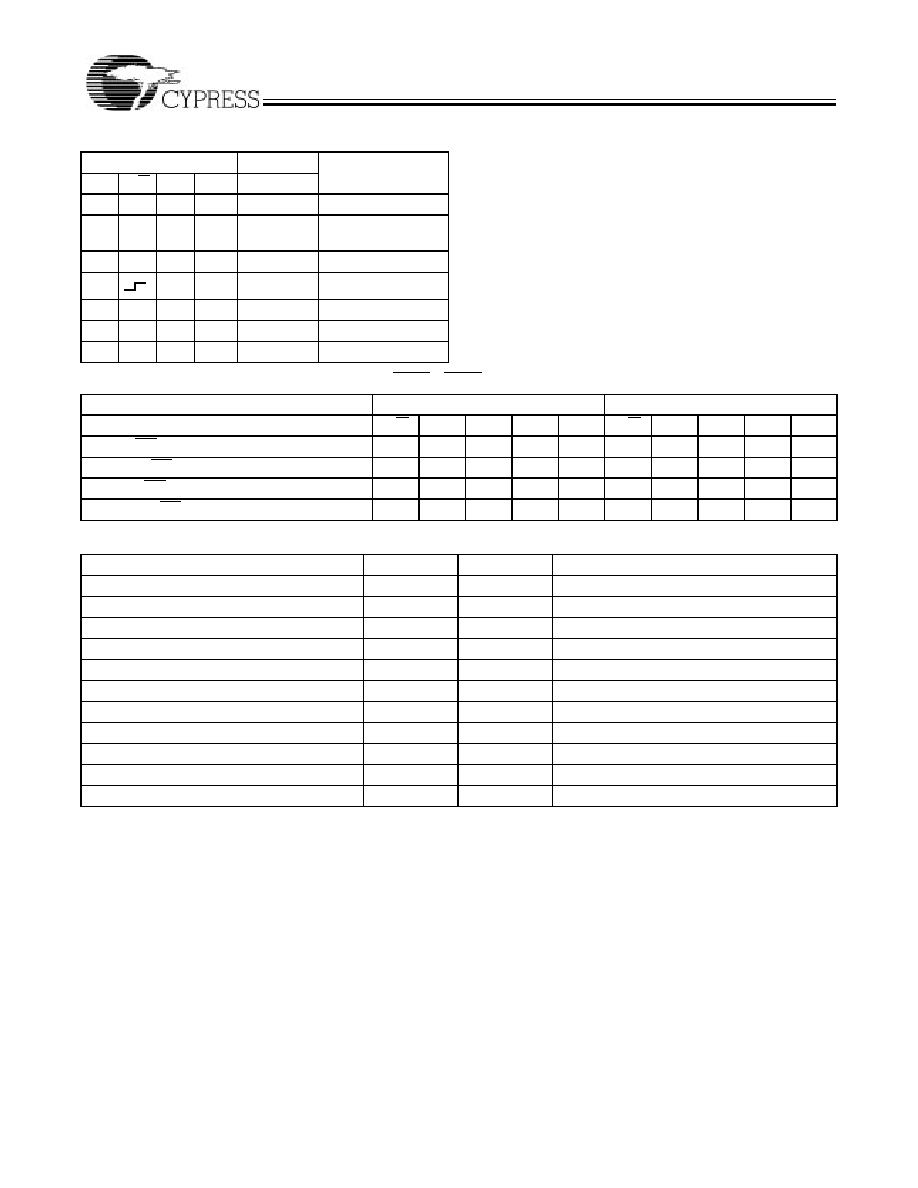
CY7C138
CY7C139
13
Table 1. Non-Contending Read/Write
Inputs
Outputs
Operation
CE
R/W
OE
SEM
I/O
0-7/8
H
X
X
H
High Z
Power-Down
H
H
L
L
Data Out
Read Data in
Semaphore
X
X
H
X
High Z
I/O Lines Disabled
H
X
L
Data In
Write to Semaphore
L
H
L
H
Data Out
Read
L
L
X
H
Data In
Write
L
X
X
L
Illegal Condition
Table 2. Interrupt Operation Example (assumes BUSY
L
=BUSY
R
=HIGH)
Left Port
Right Port
Function
R/W
CE
OE
A
0-11
INT
R/W
CE
OE
A
0-11
INT
Set Left INT
X
X
X
X
L
L
L
X
FFE
X
Reset Left INT
X
L
L
FFE
H
X
X
X
X
X
Set Right INT
L
L
X
FFF
X
X
X
X
X
L
Reset Right INT
X
X
X
X
X
X
L
L
FFF
H
Table 3. Semaphore Operation Example
Function
I/O
0-7/8
Left
I/O
0-7/8
Right
Status
No action
1
1
Semaphore free
Left port writes semaphore
0
1
Left port obtains semaphore
Right port writes 0 to semaphore
0
1
Right side is denied access
Left port writes 1 to semaphore
1
0
Right port is granted access to semaphore
Left port writes 0 to semaphore
1
0
No change. Left port is denied access
Right port writes 1 to semaphore
0
1
Left port obtains semaphore
Left port writes 1 to semaphore
1
1
No port accessing semaphore address
Right port writes 0 to semaphore
1
0
Right port obtains semaphore
Right port writes 1 to semaphore
1
1
No port accessing semaphore
Left port writes 0 to semaphore
0
1
Left port obtains semaphore
Left port writes 1 to semaphore
1
1
No port accessing semaphore
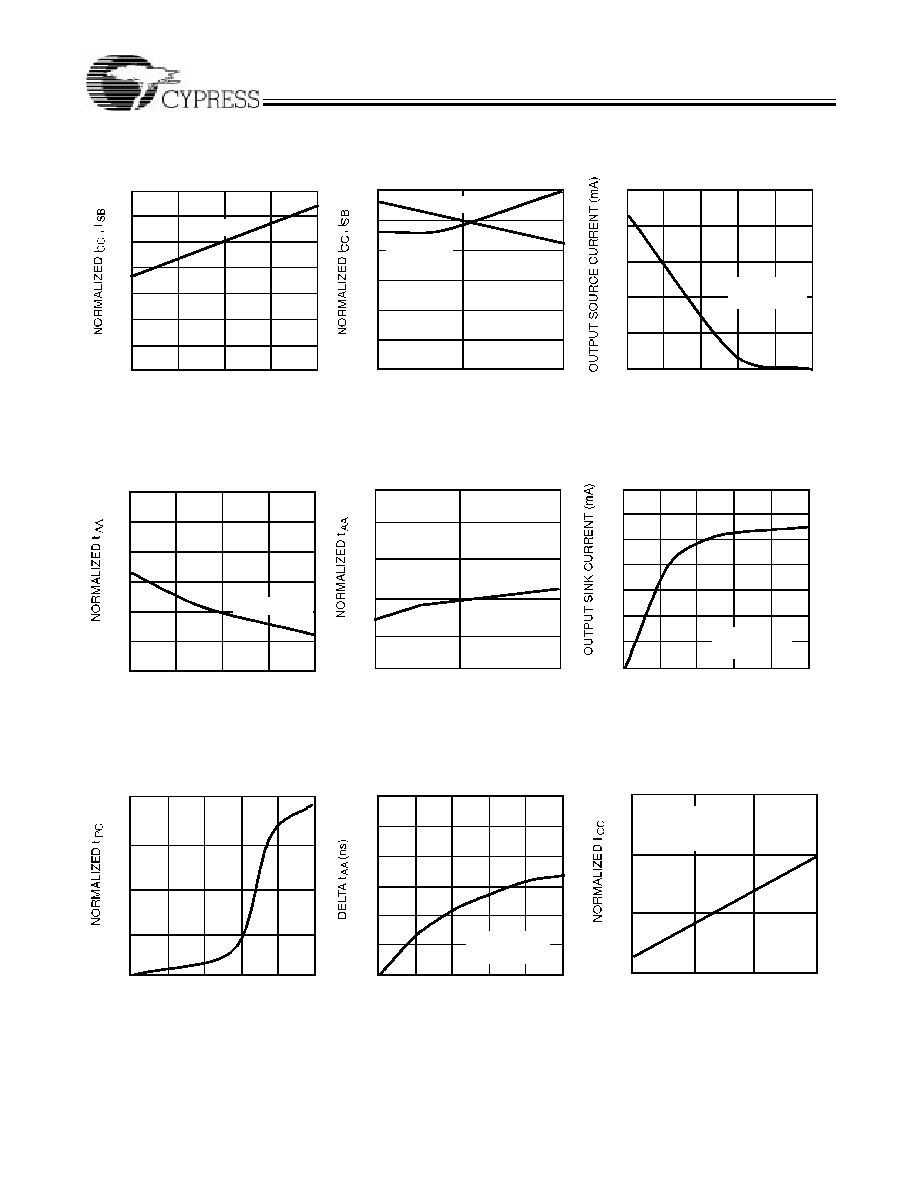
CY7C138
CY7C139
14
Typical DC and AC Characteristics
1.4
1.0
0.4
4.0
4.5
5.0
5.5
6.0
≠55
25
125
1.2
1.0
120
80
0
1.0
2.0
3.0
4.0
SUPPLYVOLTAGE (V)
NORMALIZED SUPPLY CURRENT
vs. SUPPLY VOLTAGE
NORMALIZED SUPPLY CURRENT
vs. AMBIENT TEMPERATURE
AMBIENT TEMPERATURE (∞C)
OUTPUT VOLTAGE (V)
OUTPUT SOURCE CURRENT
vs. OUTPUT VOLTAGE
0.0
0.8
0.8
0.6
0.6
V
CC
=5.0V
V
IN
=5.0V
0
I
CC
I
CC
1.6
1.4
1.2
1.0
0.8
-55
125
NORMALIZED ACCESS TIME
vs. AMBIENT TEMPERATURE
AMBIENT TEMPERATURE (∞C)
1.4
1.3
1.2
1.0
0.9
4.0
4.5
5.0
5.5
6.0
SUPPLYVOLTAGE (V)
NORMALIZED ACCESS TIME
vs. SUPPLY VOLTAGE
120
140
100
60
40
20
0.0
1.0
2.0
3.0
4.0
0
80
OUTPUT VOLTAGE (V)
OUTPUT SINK CURRENT
vs. OUTPUT VOLTAGE
VCC=5.0V
TA =25_C
0.6
0.8
V
CC
=5.0V
T
A
=25∞C
1.25
1.0
0.75
10
0.50
NORMALIZED I
CC
vs.CYCLE TIME
CYCLE FREQUENCY (MHz)
1.00
0.25
0
1.0
2.0
3.0
5.0
25.0
30.0
20.0
10.0
5.0
0
200
400
600
800
0
15.0
0.0
SUPPLYVOLTAGE (V)
TYPICAL POWER-ON CURRENT
vs. SUPPLY VOLTAGE
CAPACITANCE (pF)
TYPICAL ACCESS TIME CHANGE
vs. OUTPUT LOADING
4.0
1000
0.50
28
0.2
0.6
1.2
I
SB3
0.2
0.4
I
SB3
25
1.1
V
CC
=4.5V
T
A
=25∞C
V
CC
=5.0V
T
A
=25∞C
V
IN
=0.5V
5.0
V
CC
=5.0V
T
A
=25∞C
40
160
200
5.0
40
66
0.75

CY7C138
CY7C139
© Cypress Semiconductor Corporation, 1996. The information contained herein is subject to change without notice. Cypress Semiconductor Corporation assumes no responsibility for the use
of any circuitry other than circuitry embodied in a Cypress Semiconductor product. Nor does it convey or imply any license under patent or other rights. Cypress Semiconductor does not authorize
its products for use as critical components in life-support systems where a malfunction or failure may reasonably be expected to result in significant injury to the user. The inclusion of Cypress
Semiconductor products in life-support systems application implies that the manufacturer assumes all risk of such use and in doing so indemnifies Cypress Semiconductor against all charges.
4K x9 Dual-Port SRAM
Document #: 38≠00536
Ordering Information
4K x8 Dual-Port SRAM
Speed
(ns)
Ordering Code
Package
Name
Package Type
Operating
Range
15
CY7C138≠15JC
J81
68≠Lead Plastic Leaded Chip Carrier
Commercial
25
CY7C138≠25JC
J81
68≠Lead Plastic Leaded Chip Carrier
Commercial
CY7C138≠25JI
J81
68≠Lead Plastic Leaded Chip Carrier
Industrial
35
CY7C138≠35JC
J81
68≠Lead Plastic Leaded Chip Carrier
Commercial
CY7C138≠35JI
J81
68≠Lead Plastic Leaded Chip Carrier
Industrial
55
CY7C138≠55JC
J81
68≠Lead Plastic Leaded Chip Carrier
Commercial
CY7C138≠55JI
J81
68≠Lead Plastic Leaded Chip Carrier
Industrial
Speed
(ns)
Ordering Code
Package
Type
Package Type
Operating
Range
15
CY7C139≠15JC
J81
68≠Lead Plastic Leaded Chip Carrier
Commercial
25
CY7C139≠25JC
J81
68≠Lead Plastic Leaded Chip Carrier
Commercial
CY7C139≠25JI
J81
68≠Lead Plastic Leaded Chip Carrier
Industrial
35
CY7C139≠35JC
J81
68≠Lead Plastic Leaded Chip Carrier
Commercial
CY7C139≠35JI
J81
68≠Lead Plastic Leaded Chip Carrier
Industrial
55
CY7C139≠55JC
J81
68≠Lead Plastic Leaded Chip Carrier
Commercial
CY7C139≠55JI
J81
68≠Lead Plastic Leaded Chip Carrier
Industrial
Package Diagram
68-Lead Plastic Leaded Chip Carrier J81














